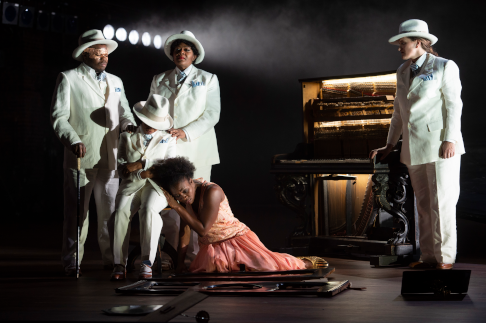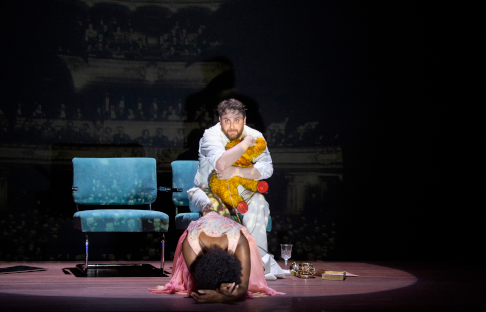![Scene from <em>Caruso a Cuba</em> [Photo © Monika Rittershaus]](http://www.operatoday.com/De%20Nationale%20Opera%20Caruso%20a%20Cuba%20-%20credits%20Monika%20Rittershaus%20217.png)
04 Mar 2019
Chameleonic new opera featuring Caruso in Amsterdam
Micha Hamel’s new opera, Caruso a Cuba, is constantly on the move. The chameleonic score takes on a myriad flavours, all with a strong sense of mood or place.
English Touring Opera are delighted to announce a season of lyric monodramas to tour nationally from October to December. The season features music for solo singer and piano by Argento, Britten, Tippett and Shostakovich with a bold and inventive approach to making opera during social distancing.
This tenth of ten Live from London concerts was in fact a recorded live performance from California. It was no less enjoyable for that, and it was also uplifting to learn that this wasn’t in fact the ‘last’ LfL event that we will be able to enjoy, courtesy of VOCES8 and their fellow vocal ensembles (more below …).
Ever since Wigmore Hall announced their superb series of autumn concerts, all streamed live and available free of charge, I’d been looking forward to this song recital by Ian Bostridge and Imogen Cooper.
Although Stile Antico’s programme article for their Live from London recital introduced their selection from the many treasures of the English Renaissance in the context of the theological debates and upheavals of the Tudor and Elizabethan years, their performance was more evocative of private chamber music than of public liturgy.
Evidently, face masks don’t stifle appreciative “Bravo!”s. And, reducing audience numbers doesn’t lower the volume of such acclamations. For, the audience at Wigmore Hall gave soprano Elizabeth Llewellyn and pianist Simon Lepper a greatly deserved warm reception and hearty response following this lunchtime recital of late-Romantic song.
For this week’s Live from London vocal recital we moved from the home of VOCES8, St Anne and St Agnes in the City of London, to Kings Place, where The Sixteen - who have been associate artists at the venue for some time - presented a programme of music and words bound together by the theme of ‘reflection’.
'Such is your divine Disposation that both you excellently understand, and royally entertaine the Exercise of Musicke.’
‘And there was war in heaven: Michael and his angels fought against the dragon; and the dragon fought and his angels, And prevailed not; neither was their place found any more in heaven … that old serpent … Satan, which deceiveth the whole world: he was cast out into the earth, and his angels were cast out with him.’
There was never any doubt that the fifth of the twelve Met Stars Live in Concert broadcasts was going to be a palpably intense and vivid event, as well as a musically stunning and theatrically enervating experience.
‘Love’ was the theme for this Live from London performance by Apollo5. Given the complexity and diversity of that human emotion, and Apollo5’s reputation for versatility and diverse repertoire, ranging from Renaissance choral music to jazz, from contemporary classical works to popular song, it was no surprise that their programme spanned 500 years and several musical styles.
The Academy of St Martin in the Fields have titled their autumn series of eight concerts - which are taking place at 5pm and 7.30pm on two Saturdays each month at their home venue in Trafalgar Square, and being filmed for streaming the following Thursday - ‘re:connect’.
The London Symphony Orchestra opened their Autumn 2020 season with a homage to Oliver Knussen, who died at the age of 66 in July 2018. The programme traced a national musical lineage through the twentieth century, from Britten to Knussen, on to Mark-Anthony Turnage, and entwining the LSO and Rattle too.
With the Live from London digital vocal festival entering the second half of the series, the festival’s host, VOCES8, returned to their home at St Annes and St Agnes in the City of London to present a sequence of ‘Choral Dances’ - vocal music inspired by dance, embracing diverse genres from the Renaissance madrigal to swing jazz.
Just a few unison string wriggles from the opening of Mozart’s overture to Le nozze di Figaro are enough to make any opera-lover perch on the edge of their seat, in excited anticipation of the drama in music to come, so there could be no other curtain-raiser for this Gala Concert at the Royal Opera House, the latest instalment from ‘their House’ to ‘our houses’.
"Before the ending of the day, creator of all things, we pray that, with your accustomed mercy, you may watch over us."
The doors at The Metropolitan Opera will not open to live audiences until 2021 at the earliest, and the likelihood of normal operatic life resuming in cities around the world looks but a distant dream at present. But, while we may not be invited from our homes into the opera house for some time yet, with its free daily screenings of past productions and its pay-per-view Met Stars Live in Concert series, the Met continues to bring opera into our homes.
Music-making at this year’s Grange Festival Opera may have fallen silent in June and July, but the country house and extensive grounds of The Grange provided an ideal setting for a weekend of twelve specially conceived ‘promenade’ performances encompassing music and dance.
There’s a “slide of harmony” and “all the bones leave your body at that moment and you collapse to the floor, it’s so extraordinary.”
“Music for a while, shall all your cares beguile.”
The hum of bees rising from myriad scented blooms; gentle strains of birdsong; the cheerful chatter of picnickers beside a still lake; decorous thwacks of leather on willow; song and music floating through the warm evening air.
![Scene from <em>Caruso a Cuba</em> [Photo © Monika Rittershaus]](http://www.operatoday.com/De%20Nationale%20Opera%20Caruso%20a%20Cuba%20-%20credits%20Monika%20Rittershaus%20217.png)
Micha Hamel’s new opera, Caruso a Cuba, is constantly on the move. The chameleonic score takes on a myriad flavours, all with a strong sense of mood or place.
With 19th century Italian opera tunes flowing into Afro-Cuban percussion and chromatic free falls, there is never a dull moment in this fictionalized account of tenor Enrico Caruso’s 1920 visit to Cuba. It has meaty roles for the lead singers too. Regrettably, its world premiere at Amsterdam’s annual Opera Forward Festival was hobbled with a confusing staging that made it hard to keep track of plot, location and minor characters.
Hamel also wrote the Italian libretto, inspired by a novel by the Cuban-Puerto Rican writer Mayra Montero, available in English as The Messenger. When a bomb goes off at a theatre in Havana where Caruso is singing in Verdi’s Aida, an explosion that really happened, he runs outside, into the arms of a local woman, Aida. They fall in love, an event foreseen by her godfather Calazán, who is a priest of the Santería or, more correctly, Lucumí religion. Aida helps Caruso escape the mafia, who is trying to extort money from him, and becomes pregnant with his child. During this romantic, disorienting interlude, Caruso the famous tenor becomes Caruso the man. A ritual dunking in a lagoon fails to restore his peace of mind. Crumbling under stress, he leaves Aida, as he must, to return to his wife and to being a stage and gramophone star. Hamel has fun with 19th-century Italian operatic idiom, quoting from Aida and using Caruso’s own recorded voice, and composing a rousing cabaletta for the lovers. He evokes the tenor’s nostalgia for his youth with a mandolin, adapting the Neapolitan evergreen Torna a Surriento. A synthesizer adds atmospheric sounds, including stylized birdsong. As the story draws to a close, the score becomes progressively less tonal. The opera ends in the antithesis of music, a series of high-pitched tones imitating tinnitus, presaging the tenor’s death the following year.

It is a shame that Johannes Erath’s staging did little to elucidate the plot, mostly played out on and around a giant gramophone record, although the cast also spilled into the aisles and side boxes. Whether it was the real Cuba or Caruso’s fevered brain, the set was a dark, dismal place. Video projections added rain and a theatre interior. Alienation techniques such as slow-motion movement and having characters converse with their backs to each other worked against the singers’ emotional engagement. Design visuals were also murky, drowning secondary characters into a sea of interchangeable suits. And it shouldn’t be necessary to consult the program booklet to discover that a giant scallop shell refers to a Lucumí fortune-telling method involving a seashell necklace. When not inflicting spectator fatigue, the staging was often downright silly. The audience tittered when the bomb, its shell printed with Caruso’s name, descended gingerly from the theatre ceiling before exploding. The banal, manic choreography reached its nadir with jazz hands during the lagoon ritual. Perplexingly, orchestral intermezzi were played to a closed curtain, even when the scenery didn’t change. Thank goodness for the performances.
Although not always dead on pitch, a zesty Netherlands Chamber Orchestra, led by Otto Tausk, delivered a vibrantly robust performance. The cast was equally fired up. Airam Hernández may not be the reincarnation of Caruso, but he’s a tenor and a half with a full-blooded Italianate sound. He sang like he believed he could be the greatest tenor of his time, and so we believed it too, relishing his burnished lyricism. Aida is a challenging role, requiring technical and stylistic virtuosity. Soprano Jeanine De Bique inhabited it with tenacious passion, vocal deftness and a beguiling stage presence. Just as striking was mezzo-soprano Tichina Vaughn as her mother, who created a potent scene when warning the lovers not to defy the gods. As Calazán, Simon Shibambu intoned his prophecies with a deep, steady legato.

The supporting cast, taking on multiple roles, sparked with energy, but neither blocking nor costumes helped with sorting out which singer was playing which character at which point. Woolly bass Gabriel Rollinson portrayed an assortment of shady and upright characters. Bass-baritone Cody Quattlebaum and baritone Michael Wilmering sang with devilish gusto as, respectively, Caruso’s manager and the opera impresario. Eva Kroon’s mezzo was beautiful and buttery. We know she played a cook because the credits told us so, although she did mention "my kitchen". Perhaps the stage direction and design should not get all the blame for the blurriness. Could the two-hour one-acter have benefitted from having fewer characters? The libretto does get a bit tangled at the end, with various characters making various mystical pronouncements. On the other hand, its language also becomes more poetic, in keeping with the focus zooming inward into Aida and Caruso’s psyches. Hamel’s music certainly deserves a wider audience. Several excerpts called for a second hearing, even as standalone numbers. Besides the mother’s dramatic solo, there is an originally constructed love duet, with a stormy orchestral refrain interrupting the lovers’ exchanges. The impressive vocal ensemble accompanying the underwater ritual flared into a wild percussive climax. And Aida’s piercing monologue, delivered by De Bique with a glass-like fragility, was the best thing about the finale.
Jenny Camilleri
Cast and production information:
Enrico Caruso, Famous Singer: Airam Hernández; Aida, Girl: Jeanine De Bique; Calazán, Aida’s Godfather: Simon Shibambu; Bruno Zirato, Caruso’s Manager and Assistant: Cody Quattlebaum; Adolfo Bracale, Impresario/Reporter/Ritual Singer: Michael Wilmering; Aida’s Mother/Ritual Singer: Tichina Vaughn; Cook/Woman/Ritual Singer: Eva Kroon; Arturo Cidre/Intruder/Tata/Ritual Singer: Gabriel Rollinson. Director: Johannes Erath; Set Design: Katrin Connan; Costume Design: Noëlle Blancpain; Lighting Design: Bernd Purkrabek; Video: Bibi Abel. Conductor: Otto Tausk. Netherlands Chamber Orchestra. Seen at Internationaal Theater Amsterdam, Amsterdam, on Sunday, the 3rd of March, 2019.